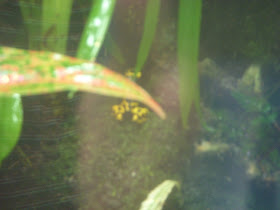Appropriately enough, the Taipei Zoo's reptile (and amphibian) house is situated close to Bird World. It is surrounded by a number of open-air exhibits, such as this Aldabra giant tortoise.
Some yellow-headed tortoises and Asian brown tortoises.
A green iguana.
Inside the reptile house itself there were these red-footed tortoises.
A poison-dart frog.
A constrictor snake of some sort.
A horned frog (or Pacman frog, after its large mouth). As with most frogs this one will eat anything that moves and can fit into its mouth, which can include very large prey indeed for horned frogs. (One can only imagine what the giant Cretaceous horned frog Beelzebufo would have been able to eat - until someone does a quantitative study or finds stomach contents!)
Another (presumably constrictor) snake.
A female plumed basilisk, noticeably lacking the crests of the male.
... What can I say? I'm bad at remembering snakes?
These are Burmese star tortoises.
An Indian star tortoise.
A yellow-margined box turtle. Its Chinese name translates to "snake-eating turtle", but it isn't actually specialized for preying on snakes. I may have read somewhere that this misnomer was derived from misinterpreted observations of cases where snakes somehow became trapped by the hinged shell of these turtles.
A spur-thighed tortoise (native to areas surrounding the Mediterranean, not to be confused with the African spurred tortoise, which lives in the Sahara Desert).
A Central Asian tortoise.
An Amur rat snake.
A common rat snake.
Blurry picture of a rattlesnake.
Some radiated tortoises.
A hundred-step pit viper, so called due to a local belief that it takes just a hundred steps after being bitten by this snake for its venom to kill you.
A glass lizard wedged in a crevice.
A king snake, I think.
A bearded dragon.
A Cuban ground iguana.
A leopard gecko.
A common wonder gecko. The geckos were kept in dimly-lit terrariums to reflect their nocturnal habits.
A Madagascan swift, not to be confused with its fellow diapsid the Madagascar swift.
A tortoise for which I foolishly forgot to take a picture of its sign, though that may have been because my camera was running on low battery by this point.
A hog-nosed snake, well known for its extensive display of thanatosis when threatened (as well as the fact that it can be forced to give itself away when rolled onto its belly in this state).
A rough-scaled plated lizard.
A spectacled toad.
At this point my camera died so I couldn't get any photos of the last stretch of my trip. At the back of the zoo is a section dedicated to animals from temperate regions of the world, with exhibits for wolves, red pandas, brown bears, Asiatic black bears, raccoons, woodchucks, beavers, river otters, bobcats, lynxes, mountain lions, bison, pelicans, Père David's Deer, and Przewalski's horses. There's also a penguin house in that general area with king penguins and black-footed penguins. (Amusingly, the exhibit signs chose the name "jackass penguin" for the latter in their English translation.) Finally, I had a look at the zoo's koala house near the zoo entrance.































Wow, you've really covered quite a lot. The variety of tortoises and snakes is also quite impressive. What makes lizards so widely adaptable and diverse?.
ReplyDeleteNot being a lizard person, I can't really say anything more specific than their general body plan appears to work well in a wide variety of environments.
Delete